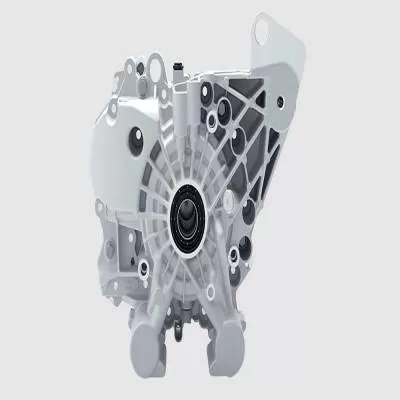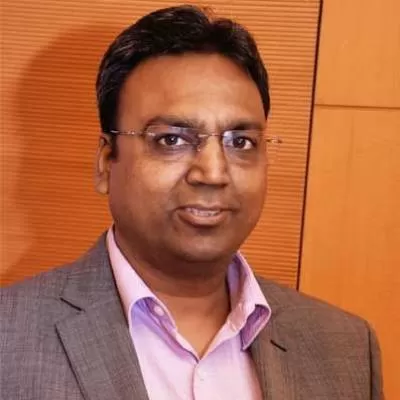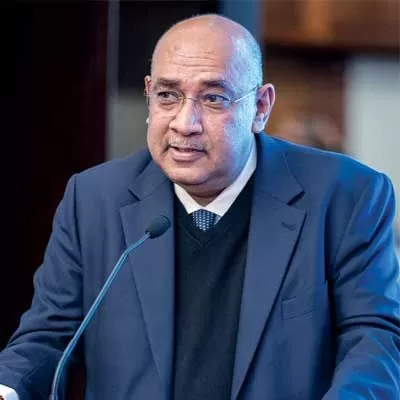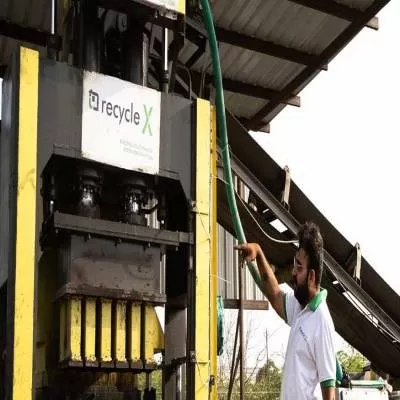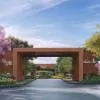- Home
- Infrastructure Urban
- ECONOMY & POLICY
- A Hope Fulfilled for Meena Devi

A Hope Fulfilled for Meena Devi
The ride to house number A-65 in the Sainik Enclave locality of New Delhi's Vikas Nagar is a bumpy one. The narrow lanes that crisscross the area are peppered with potholes of varying sizes. The previous night's rain has only made matters worse as certain stretches along the way are waterlogged. After parking their vehicle near a vacant plot that has long since become a garbage heap, visitors have to walk down for a couple of minutes more before turning right into a smaller lane to reach the final destination. Like most houses in the area, the lane has basic brick-and-mortar dwellings that often rise up to three floors. In this setting, the freshly painted yellow structure of A-65, however, stands out.
In a house buzzing with activity on the day of its inauguration on a humid Delhi summer afternoon, its owner Meena Devi is mighty pleased. A widow with four kids, her housewarming is finally happening after living two long years on rent. In place of her old ramshackle house, which had progressively sunk into the ground over the past two decades, stands a 400-sq-m spanking new dwelling. 'It's my earnest prayer that everyone must have a home to call their own,' she remarks.
Meena's house is a result of a corporate social responsibility (CSR) initiative termed 'Umeed Ki Awaaz' or cry of hope by one of the world's leading polymer firms, Covestro, in partnership with the international NGO Habitat for Humanity.
'The major challenge right now for our economy is the way we are consuming,' says Ajay Durrani, Managing Director, Covestro India. 'In the next 15 to 20 years, we will be confronted with a dilemma when most resources would have become scarce. To extend the life of all those consumables, we need to come up with a policy or understanding that all our functions should have sustainability as a part of human development.'
In the Union Budget 2017-18, the Central Government has laid special emphasis on affordable housing by assigning infrastructure status to such projects. It has also committed to facilitate higher investments in the sector to meet its stated objective of providing 'Housing for All by 2022'. This, together with India signing the Paris Agreement in 2016, has provided the realty sector with an incentive to adopt sustainability as one of its core pillars.
Vikas Vihar is part of the census town of Hastsal, which lies in West Delhi. Largely a lower middle income area, its name literally translates as the home of elephants. Old-timers believe Mughal emperor Shah Jahan (1592-1666) maintained a hunting lodge here.
The home has been built using Covestro's eco-sensitive technology. It is to this end that the award-winning, energy-efficient, three-layered panel made of composite materials has been utilised in construction of the house. Made from locally available recyclable materials, Covestro partnered with Industrial Foams, New Delhi, and Vaspar Eco Systems, Bengaluru, to develop these panels, which are aimed at making technologically and socially relevant innovations widely accessible.
The house was constructed using fit-for-purpose cement fibre board, polyurethane foam (PUF) and paper honeycomb blocks. That makes it not only thermally comfortable and energy-efficient, but enables it to withstand extremes of weather and natural disasters. The technology has been successfully tried and tested globally over the past several years.
'Similar houses need to be constructed in rural India wherever people are staying in shacks,' says Samir Arora, Managing Director, Industrial Foams. 'Today, everybody deserves a comfortable level of living. This can be a good way to introduce the technology of prefabricated homes across the country.ö He further observes that the technology may come in handy to rehabilitate slum dwellers in cities. Once all regulatory approvals are in place, it takes nearly two weeks to assemble a residential unit using the materials.
Other than Meena's house, two other units of 180 sq ft and 300 sq ft are also coming up using the same technology in Vikas Vihar.
The median cost of construction of these units is 10 per cent less than that of conventional dwellings.
As Mukul Dixit, Senior Director, Programmes and Operations, Habitat for Humanity, shares, ôWe thoroughly examined the technology and consulted with the families concerned and our partner. As acceptance of a new technology can be difficult, it proved to be a lengthy exercise running over six months.'
Through such initiatives, Covestro also endeavours to explore opportunities for new applications of its high-tech polymers, especially in underdeveloped markets. The firm has already completed a three-storied building in Jaipur using polyisocyanurate (PIR). It now intends to roll out the affordable housing initiative in rural areas as well. ôThe opportunity for growth is enormous, not just in the affordable housing segment but from the perspective of energy-efficiency,ö avers Durrani. ôYou can look at constructing malls, warehouses and insulated public buildings with the help of this technology.'
- Manish Pant
To share your views on this article, write in at feedback@ConstructionWorld.inA solution designed by one of the world's leading polymer firms, Covestro, and its programme partners, might provide a viable alternative for construction of sustainable and energy-efficient affordable homes across India. The ride to house number A-65 in the Sainik Enclave locality of New Delhi's Vikas Nagar is a bumpy one. The narrow lanes that crisscross the area are peppered with potholes of varying sizes. The previous night's rain has only made matters worse as certain stretches along the way are waterlogged. After parking their vehicle near a vacant plot that has long since become a garbage heap, visitors have to walk down for a couple of minutes more before turning right into a smaller lane to reach the final destination. Like most houses in the area, the lane has basic brick-and-mortar dwellings that often rise up to three floors. In this setting, the freshly painted yellow structure of A-65, however, stands out. In a house buzzing with activity on the day of its inauguration on a humid Delhi summer afternoon, its owner Meena Devi is mighty pleased. A widow with four kids, her housewarming is finally happening after living two long years on rent. In place of her old ramshackle house, which had progressively sunk into the ground over the past two decades, stands a 400-sq-m spanking new dwelling. 'It's my earnest prayer that everyone must have a home to call their own,' she remarks. Meena's house is a result of a corporate social responsibility (CSR) initiative termed 'Umeed Ki Awaaz' or cry of hope by one of the world's leading polymer firms, Covestro, in partnership with the international NGO Habitat for Humanity. 'The major challenge right now for our economy is the way we are consuming,' says Ajay Durrani, Managing Director, Covestro India. 'In the next 15 to 20 years, we will be confronted with a dilemma when most resources would have become scarce. To extend the life of all those consumables, we need to come up with a policy or understanding that all our functions should have sustainability as a part of human development.' In the Union Budget 2017-18, the Central Government has laid special emphasis on affordable housing by assigning infrastructure status to such projects. It has also committed to facilitate higher investments in the sector to meet its stated objective of providing 'Housing for All by 2022'. This, together with India signing the Paris Agreement in 2016, has provided the realty sector with an incentive to adopt sustainability as one of its core pillars. Vikas Vihar is part of the census town of Hastsal, which lies in West Delhi. Largely a lower middle income area, its name literally translates as the home of elephants. Old-timers believe Mughal emperor Shah Jahan (1592-1666) maintained a hunting lodge here. The home has been built using Covestro's eco-sensitive technology. It is to this end that the award-winning, energy-efficient, three-layered panel made of composite materials has been utilised in construction of the house. Made from locally available recyclable materials, Covestro partnered with Industrial Foams, New Delhi, and Vaspar Eco Systems, Bengaluru, to develop these panels, which are aimed at making technologically and socially relevant innovations widely accessible. The house was constructed using fit-for-purpose cement fibre board, polyurethane foam (PUF) and paper honeycomb blocks. That makes it not only thermally comfortable and energy-efficient, but enables it to withstand extremes of weather and natural disasters. The technology has been successfully tried and tested globally over the past several years. 'Similar houses need to be constructed in rural India wherever people are staying in shacks,' says Samir Arora, Managing Director, Industrial Foams. 'Today, everybody deserves a comfortable level of living. This can be a good way to introduce the technology of prefabricated homes across the country.ö He further observes that the technology may come in handy to rehabilitate slum dwellers in cities. Once all regulatory approvals are in place, it takes nearly two weeks to assemble a residential unit using the materials. Other than Meena's house, two other units of 180 sq ft and 300 sq ft are also coming up using the same technology in Vikas Vihar. The median cost of construction of these units is 10 per cent less than that of conventional dwellings. As Mukul Dixit, Senior Director, Programmes and Operations, Habitat for Humanity, shares, ôWe thoroughly examined the technology and consulted with the families concerned and our partner. As acceptance of a new technology can be difficult, it proved to be a lengthy exercise running over six months.' Through such initiatives, Covestro also endeavours to explore opportunities for new applications of its high-tech polymers, especially in underdeveloped markets. The firm has already completed a three-storied building in Jaipur using polyisocyanurate (PIR). It now intends to roll out the affordable housing initiative in rural areas as well. ôThe opportunity for growth is enormous, not just in the affordable housing segment but from the perspective of energy-efficiency,ö avers Durrani. ôYou can look at constructing malls, warehouses and insulated public buildings with the help of this technology.' - Manish Pant To share your views on this article, write in at feedback@ConstructionWorld.in




